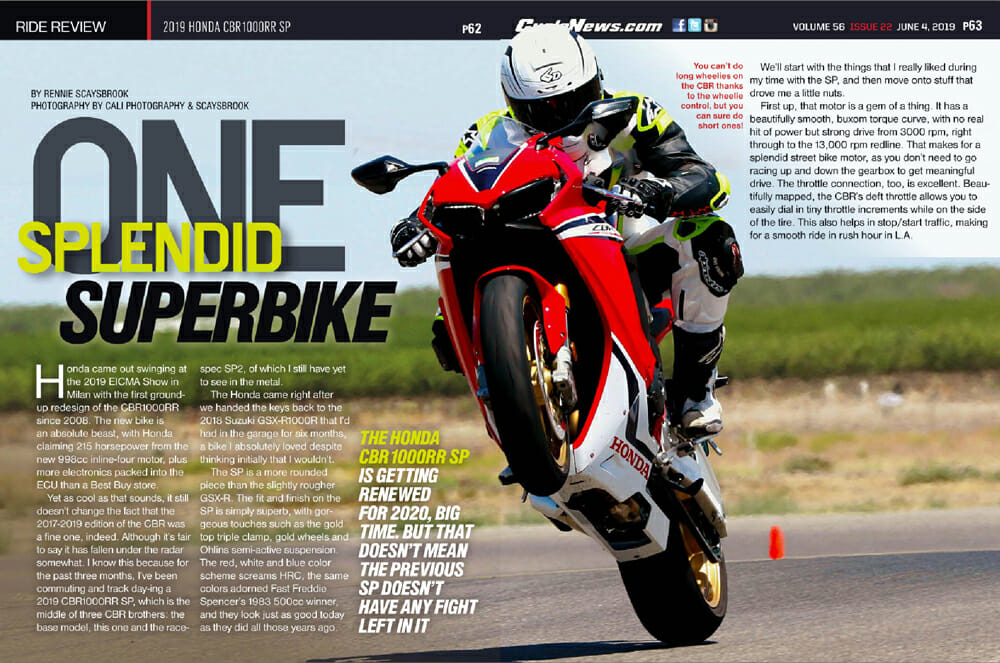Rennie Scaysbrook | December 6, 2019
The Honda CBR1000RR SP is getting renewed, big time, for 2020. But that doesn’t mean the previous SP doesn’t have any fight left in it.
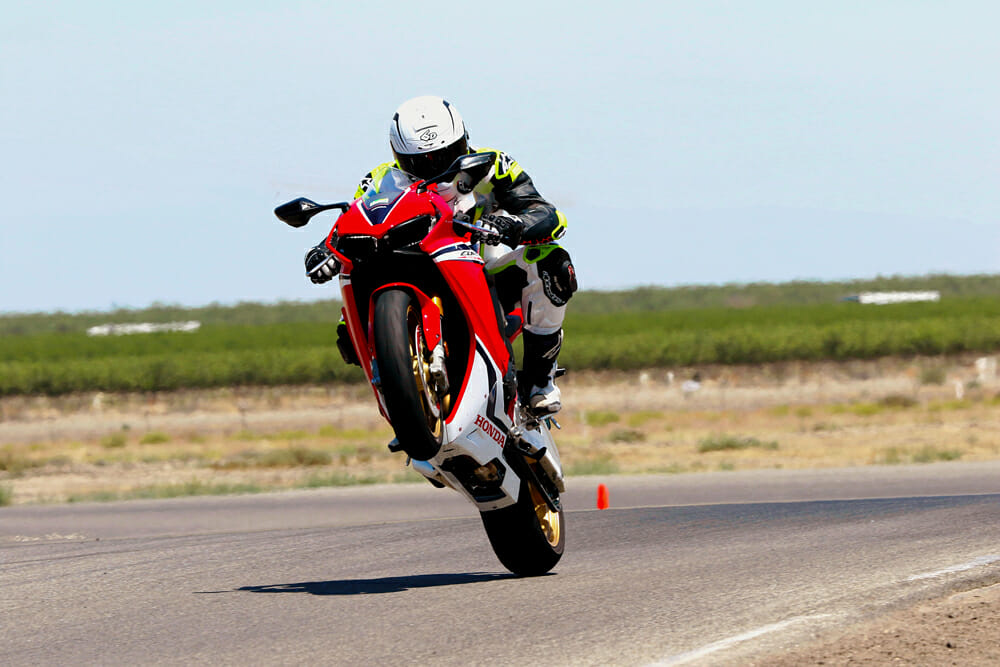 You can’t do long wheelies on the CBR thanks to the wheelie control, but you can sure do short ones!
You can’t do long wheelies on the CBR thanks to the wheelie control, but you can sure do short ones!
Photography by Cali Photography and Rennie Scaysbrook
Honda came out swinging at the 2019 EICMA Show in Milan with the first ground up redesign of the CBR1000RR since 2008. The new bike is an absolute beast, with Honda claiming 215 horsepower from the new 998cc inline-four motor, plus more electronics packed into the ECU than a Best Buy store.
Yet as cool as that sounds, it still doesn’t change the fact the 2017-2019 edition of the CBR was a fine one, indeed, although it’s fair to say it has fallen under the radar somewhat. I know this because for the past three months, I’ve been commuting and track day-ing a 2019 CBR1000RR SP, which is the middle of three CBR brothers in the base model, this one and the race-spec SP2, of which I’m still yet to see one in the metal.
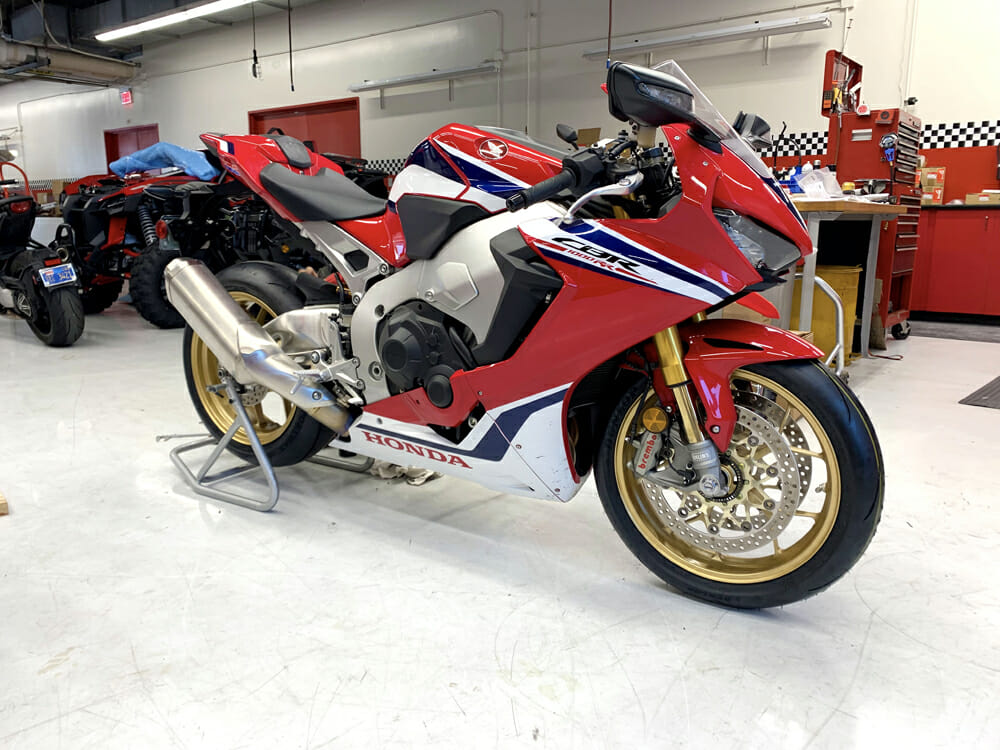 In the Honda shop, the CBR is indeed a looker. Just look at that swingarm.
In the Honda shop, the CBR is indeed a looker. Just look at that swingarm.
The Honda came right after we handed the keys back to the 2018 Suzuki GSX-R1000R that I’d had in the garage for six months, a bike I absolutely loved despite thinking initially that I wouldn’t.
The SP is a more rounded piece than the slightly rougher GSX-R. The fit and finish on the SP is simply superb, with gorgeous touches in the gold top triple clamp, gold wheels and Ӧhlins semi-active suspension. The red, white and blue color scheme screams HRC, the same colors adorned Fast Freddie Spencer’s 1983 500cc winner, and they look just as good today as they did all those years ago.
We’ll start with the things that I really liked during my time with the SP, and then move onto stuff that drove me a little nuts.
First up, that motor is a gem of a thing. It has a beautifully smooth, buxom torque curve, with no real hit of power but strong drive from 3000 rpm, right through to the 13,000 rpm redline. That makes for a splendid street bike motor, as you don’t need to go racing up and down the gearbox to get meaningful drive. The throttle connection, too, is excellent. Beautifully mapped, the CBR’s deft throttle allows you to easily dial in tiny throttle increments while on the side of the tire. This also helps in stop/start traffic, making for a smooth ride in rush hour in LA.
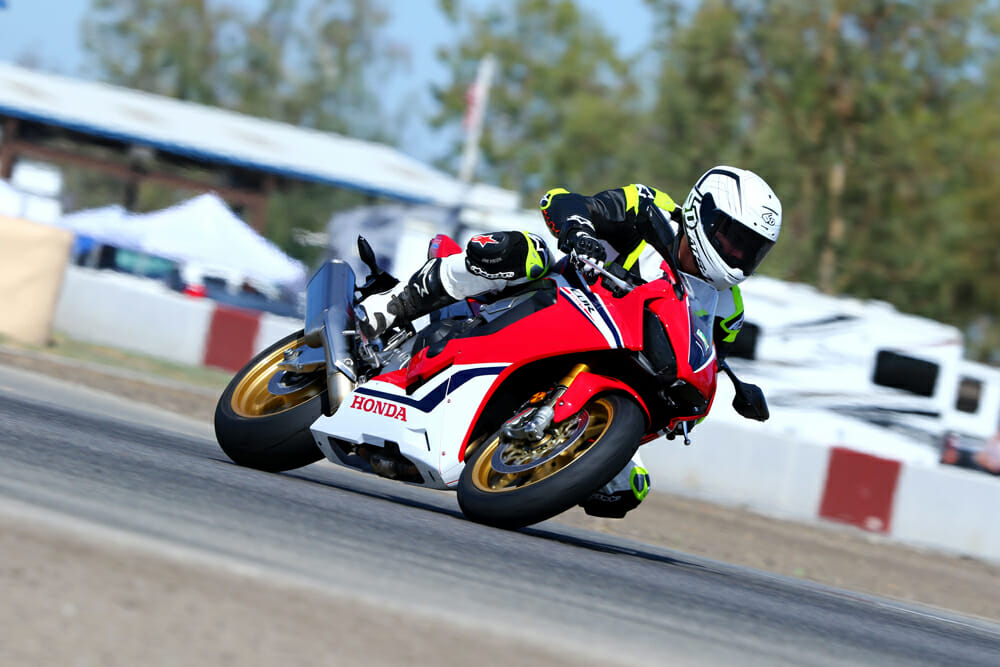 Three laps in at Buttonwillow and Rennie already wishes he had some steel brake lines.
Three laps in at Buttonwillow and Rennie already wishes he had some steel brake lines.
The SP motor also doesn’t produce the vibrations the old 2008-2016 model did, so longer rides are not as bad on your wrists and feet.
Another area I loved was the gearbox. Matched to the up and down quickshifter, the CBR’s gearbox is super slick and that light, positive shift is at odds with something you’ll find on a pre-2019 BMW S 1000 RR.
Ergonomics-wise, the CBR is much better than it was before. The 2008-2016 model had a ridiculously short space between the seat and footpegs, meaning it felt like your knees were up around your ears. This model is much roomier, despite being essentially the same chassis, thanks in partial to a reworked seat and how your knees sit at the gas tank. It’s still a head down/ass up superbike, so don’t go thinking it’s naked bike-style comfortable, but it’s better than what it was.
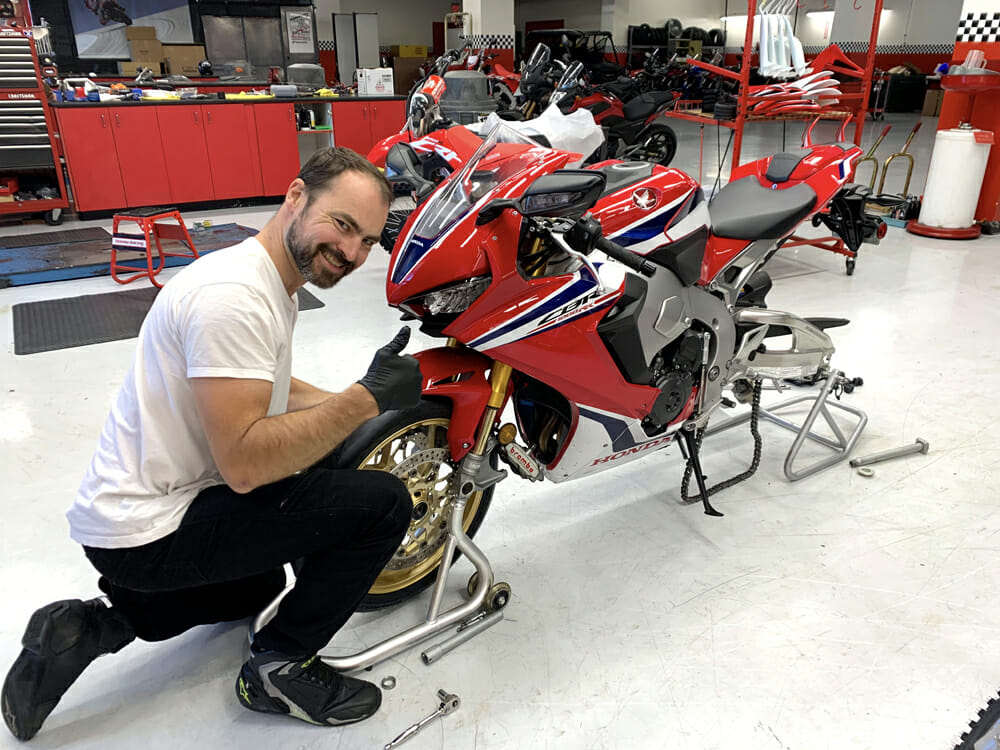 “You want a test bike? You have to change your own tires, boy!”
“You want a test bike? You have to change your own tires, boy!”
Here’s a couple of things I didn’t like in the CBR.
The first was the lack of cruise control. I made this gripe about the GSX-R as well, but a 1000cc motorcycle costing $20,000 should have that little flick of the switch that makes touring (stuff some people actually do on a CBR) that much more enjoyable. The bike has wheel-speed sensors and a ride-by-wire throttle, so there’s no reason cruise control should be omitted from the package.
The second is the rubber brake lines, which faded after about three hard laps on track. A premium product like this should not have such penny-saving measures in place, especially when you’ve got stuff like electronic Ӧhlins suspension at your disposal.
On the street, brake performance was fine, but it was always in the back of my mind that I had to be extra careful on the brakes at the hard-braking venue of Buttonwillow in California. Having such great Brembo monoblocs matched to those brake lines should be illegal.
One of the most annoying things on track was the wheelie control. When I tested the first version of the SP in 2017 at Portimao, the single biggest gripe I had with the bike was that the traction and wheelie control algorithms were linked, meaning that if you did a power wheelie, the ECU would chop the power drastically. It was awfully annoying, and for 2018 the Honda engineers separated the wheelie- and traction-control systems so they work independently of each other.
The problem is, you can’t switch the wheelie control off. On track, this became a real pain, as I couldn’t carry a floating wheelie while hard on the gas as I tried to maximize acceleration. I also couldn’t pop a proper wheelie, which, when you have this much power, is a real downer.
I get why Honda did such a thing (because safety), but if you have a system such as wheelie control, you should be able to turn it off.
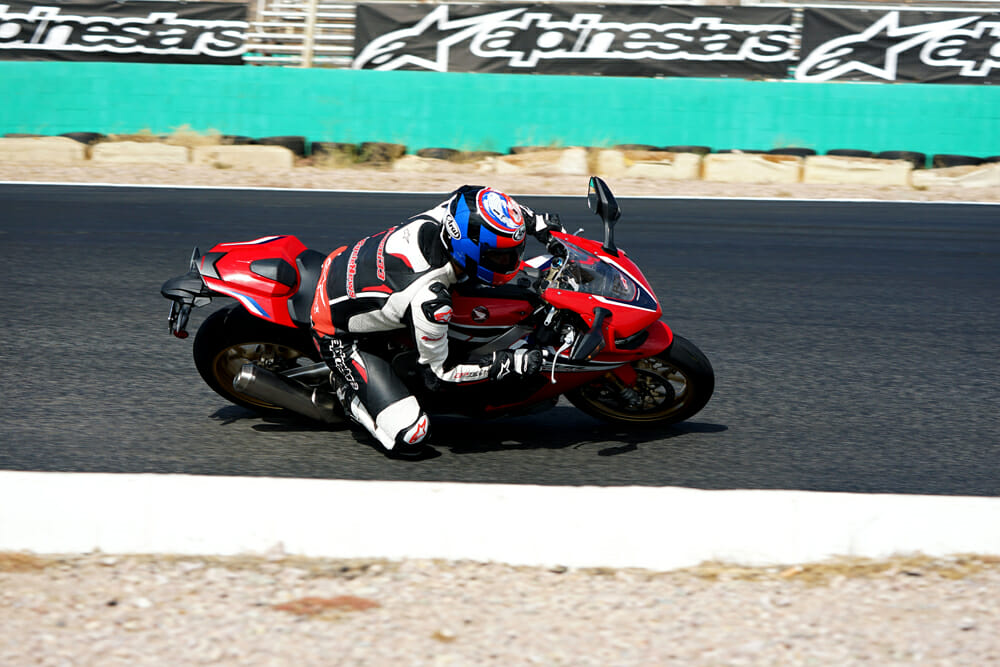 The abysmal surface at Willow Springs highlighted the limits of the first-generation Ӧhlins electronic suspension.
The abysmal surface at Willow Springs highlighted the limits of the first-generation Ӧhlins electronic suspension.
An interesting aspect of my time with the CBR was the performance of the electronic Ӧhlins suspension. The system fitted to the 2019 CBR is the first-generation Smart EC (electronic control), and since I’ve ridden on the Smart EC 2 on a Ducati Panigale (among others), it’s interesting to see how far the system has come in such a short time span.
The CBR gets six modes, three auto and three manual modes, and I left it in the stiffest auto setting (level one) most of the time I had it. Over rough streets, the performance was good, but when transported to the track, the ride was different altogether.
At Willow Springs in both the stiff manual and auto modes, the ride was not optimal. Willow Springs is rough as guts anyway, and this magnified the Ӧhlins’ short comings. The ride was harsh, with the rebound in auto especially abrupt on the fork.
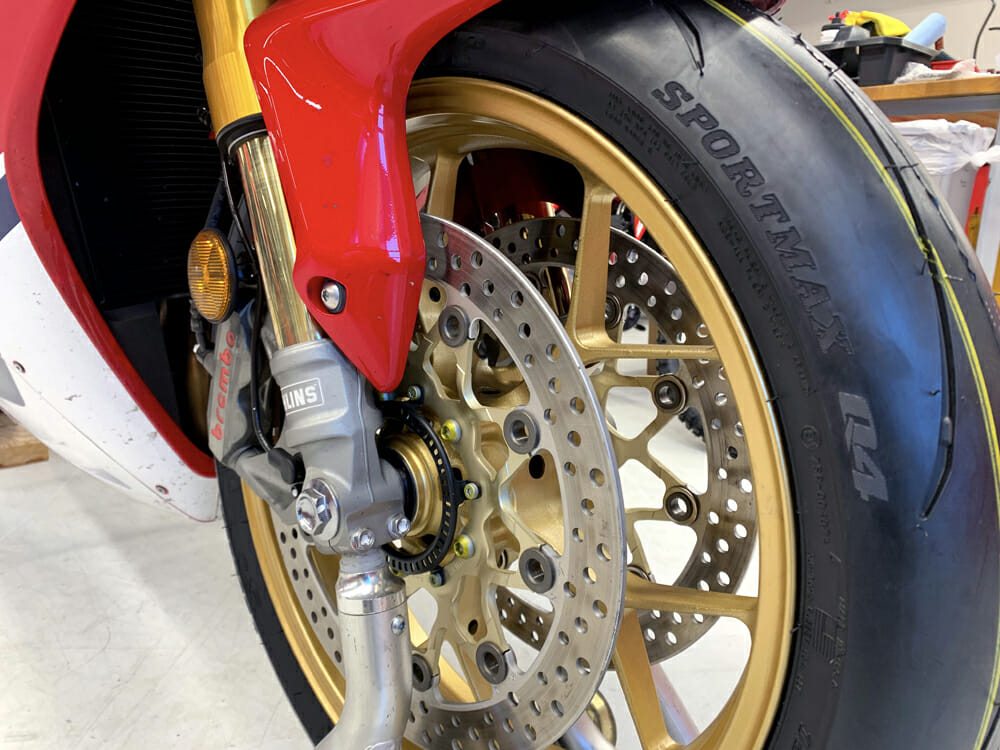 We also threw a set of Dunlop Sportmax Q4s at the CBR. We’ll have a test on those soon.
We also threw a set of Dunlop Sportmax Q4s at the CBR. We’ll have a test on those soon.
At the back, the CBR’s suspension performed better, but it was far from the smooth ride I remembered at Portimao.
Switching to the road and with everything softened off, in auto mode, the CBR was quite a nice bike to ride. It would still wallow and protest if you hit big bumps hard, but if you got out of the seat and let the chassis soak some of the bumps more, the ride was altogether pretty good.
During my time on the CBR, I averaged about 32 miles per gallon, which was a touch more mileage than I got out of the GSX-R at 30 mpg. That would get me from home to work and back on a single tank, although I’d be searching for a gas station when I got close to home.
With Honda bringing out the animal that is the 2020 CBR1000RR Fireblade SP to give it its full and correct title, this CBR will represent some pretty astute buying in the coming months as dealers try to ride themselves of old, but still very fast, stock.
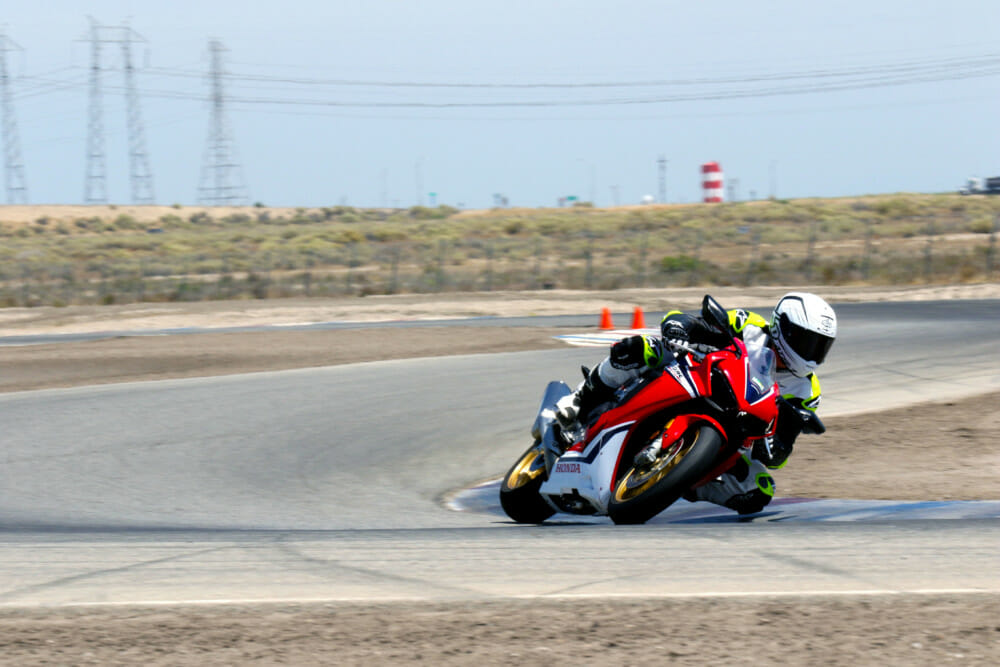 The CBR’s superbly smooth throttle connection is very welcomed in Buttonwillow’s chicanes.
The CBR’s superbly smooth throttle connection is very welcomed in Buttonwillow’s chicanes.
The overall impression I had of the CBR was of a good bike, but one that had some unnecessary corners cut. Stuff like the brake lines are an easy fix, but the wheelie control and lack of cruise control is not.
Regardless, the CBR is a fine send off to the bike that started life in 2008 (yes, this and that model are very closely related). The 2020 CBR will be a rager, but this 2019 edition could be a bargain if found at the right dealer over the next few months. CN
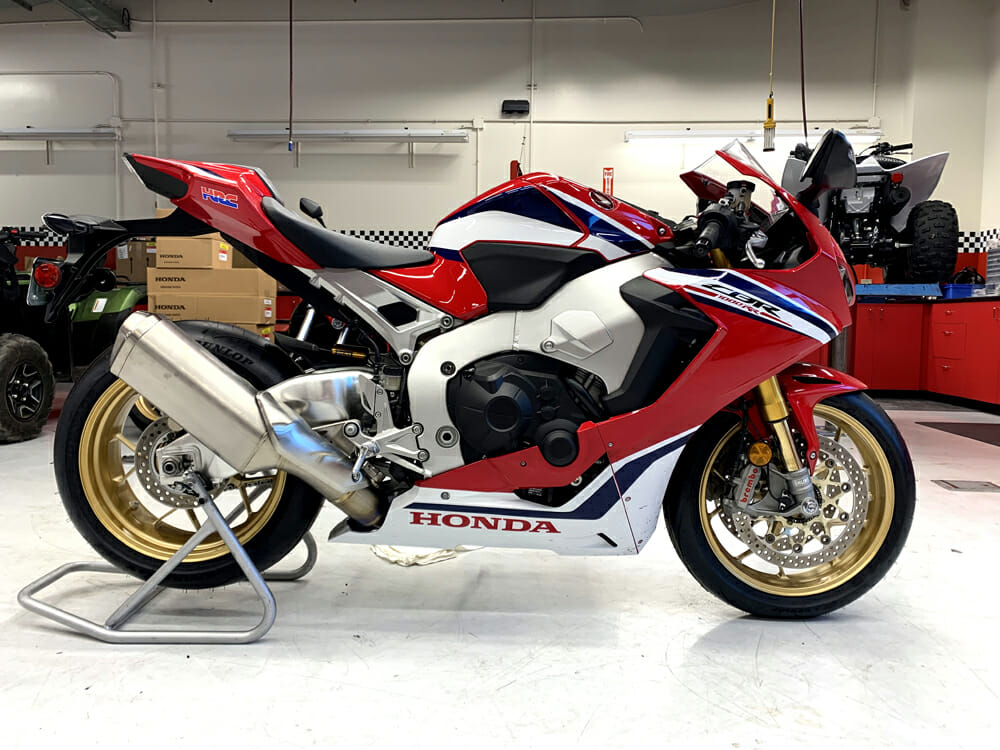
2019 Honda CBR1000RR SP Specifications
| MSRP |
$19,999 (ABS only) |
| Engine: |
Liquid cooled, 4-stroke, 16-valve, DOHC inline four |
| Displacement: |
999cc |
| Bore x stroke: |
76 x 55mm |
| Horsepower: |
189 hp @ 13,00 rpm (claimed) |
| Torque: |
84 lb-ft @ 11,000 rpm (claimed) |
| Compression ratio: |
13.0:1 |
| Fuel system: |
EFI, five variable throttle modes |
| Exhaust: |
4-2-1 |
| Transmission: |
6-speed gearbox, optional quickshifter on base model, standard on SP |
| Chassis: |
Aluminum composite twin spar |
| Front suspension: |
Öhlins NIX30 43mm inverted fork with Ohlins Smart-EC control, preload, compression and rebound damping adjustable |
| Rear suspension: |
Öhlins TTX36 rear shock with Ohlins Smart-EC control. Preload, compression and rebound damping adjustability |
| Front brake: |
Brembo radially mounted Monobloc 4-piston caliper, 320mm disc, ABS |
| Rear brake: |
Nissin single-piston caliper, 220mm diameter disc, ABS |
| Front tire: |
120/70ZR17-in. 58W |
| Rear tire: |
190/55 ZR17-in. 73W |
| Rake: |
23.3° |
| Trail: |
3.8 in. |
| Wheelbase: |
55.3 in. |
| Seat height: |
32.7 in. |
| Fuel capacity: |
4.2 gal. |
| Weigh (wet, claimed): |
428 lbs. |
| Color: |
HRC Tri-Color |
